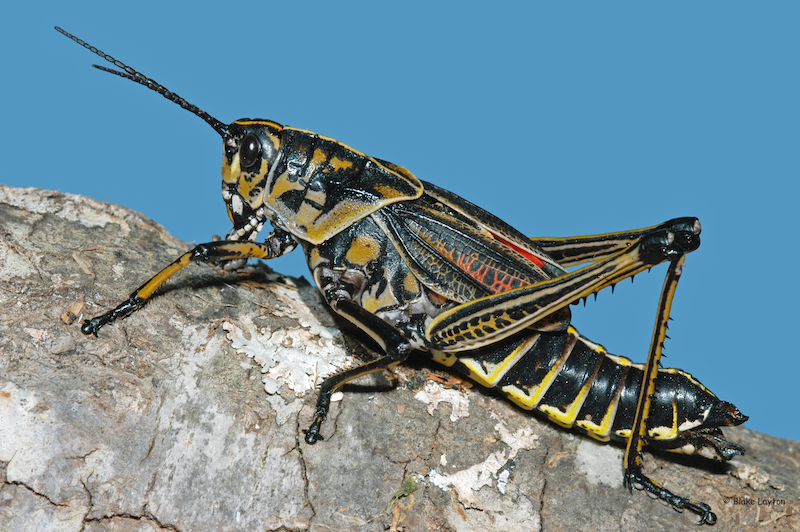Eastern Lubber Grasshopper, Vol. 7, No. 21
Romalea microptera
Order: Orthoptera
Family: Romaleidae
Eastern lubber grasshoppers are the second largest insects in the state. Some females exceed three inches and weigh as much as 12 grams. Only Eastern Hercules beetles weigh more. These grasshoppers are too big and heavy to fly; they don’t even hop very well. Their slow, clumsy movements would seem to make them easy pickings for hungry birds, racoons, and other predators, but they have ways of protecting themselves.
Because they are flightless, these grasshoppers have a very spotty distribution. You may have dozens in your yard, while Joe has never seen them at his place a mile down the road. These are insects of the deep, deep South. They are most numerous in South Mississippi and become less common farther north. We have them here in Starkville, but folks north of Tupelo/Batesville/Clarksdale never see these in their landscapes (please let us know if you have?). They also have lots of different local names: Texas grasshoppers, graveyard grasshoppers, soldier boys,
These big grasshoppers only have one generation per year, spending the winter as eggs in the soil, hatching into nymphs in the spring and maturing to adults by mid to late summer. They feed on a wide range of plants, including plants with thick, fleshy leaves like daffodils and lilies. Consequently, they can be pests. A big female or a horde of hungry nymphs can do significant damage to prized lilies and other landscape plants.
How do these klutzy, flightless insects manage to survive in a world full of grasshopper-eating predators? Chemical defenses. Black, red and yellow or orange coloration is often a warning of toxicity in nature. Some species, such as the viceroy butterfly, have adopted these colors as a bluff; they are not really toxic. But this is no bluff on the part of the eastern lubber. These grasshoppers contain toxins that can sicken or kill birds or mammalian predators that eat them. Eastern lubbers are also capable of exuding a foul-smelling foam from their spiracles, along with a hissing sound when they are disturbed. Adult grasshoppers often spread their wings when performing this defensive maneuver, exposing the bright pink color on their hind wings as a warning.
Control: For low populations, hand picking and foot stomping may be all that is necessary. Gardeners who are squeamish about squashing these large insects may choose to drop them in a container of strong soapy water instead. They can also be controlled with pyrethroid insecticides such as zeta-cypermethrin, permethrin, bifenthrin, cyfluthrin, or cyhalothrin, but it takes direct spray coverage to control large nymphs and adults. Before treating vegetables be sure the product you plan to use is labeled for the vegetable crop being treated and be sure to observe pre-harvest intervals.
See Bug's Eye View No. 25 of 2015 for information on another large grasshopper we have here, the American Bird Locust. See Bug's Eye View No. 1 of 2015 for more information on Eastern Hercules Beetles.
Blake Layton, Extension Entomology Specialist, Mississippi State University Extension Service.
The information given here is for educational purposes only. Always read and follow current label directions. Specific commercial products are mentioned as examples only and reference to specific products or trade names is made with the understanding that no discrimination is intended to other products that may also be suitable and appropriately labeled.
Mississippi State University is an equal opportunity institution.
Bug’s Eye View is now on Facebook. Join the Bug's Eye View Facebook group here.


